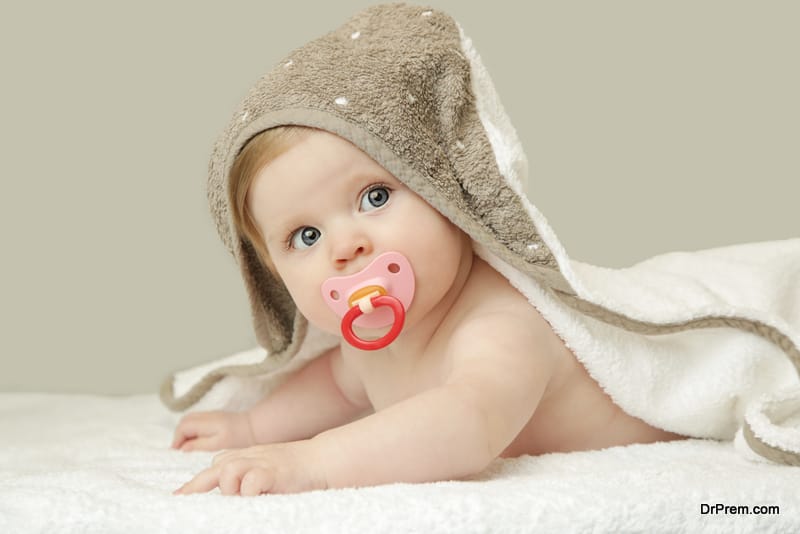Overview
Pacifiers are soothing for babies especially in the early stages of their growth. Parents, of course have certain reservations with pacifiers which may become a habit. They also feel that use of pacifiers would discourage breastfeeding which is very important for a new infant. Pacifiers can be used at bedtime for SIDS prevention and comes highly recommended by AAP. If breastfeeding is smooth and both mother and baby are doing well, there is no need to switch to pacifiers before the required time. The time period of breastfeeding is for a short period of time, which may appear endless particularly if you are not up to the strain caused by lack of sleep, physical and emotional tiredness, then as an alternative measure you can introduce a pacifier to a baby as early as one month. It is alright for babies to have pacifiers now and then even if you are breastfeeding. This is another way of preparing them for the bottle feeding when it is time to switch. Babies do not generally become dependent on pacifiers as this is a phase that they outgrow eventually.
Do’s
a. Always select a pacifier that is not breakable and do buy one piece model only. Select one that is easy to clean and dishwasher safe.
b. Get one that has ventilation holes at its base and avoid circular shields which may obstruct baby’s nostrils while sucking intensely.
c. During the early months, select a model that has a shorter, smaller and newborn size which will fit baby comfortably.
d. Always ensure that the nipple is firmly attached to the base so that baby does not tug it off. If there is a slight dent anywhere in the base, have it replaced as it is sure to be pulled out by the baby. It could lead to choking if care is not taken. There are liquid pacifiers as well and may seem a pretty alternative. However, constant use and biting by baby may result in liquid spill over which in any case may be dangerous to baby’s health.
e. Go for a pacifier which works for the baby best as you would know when baby is content with a particular kind. There are some orthodontic pacifier nipples to prevent tooth troubles later in life, as they have a rounded top and a flat bottom. Limit the amount of time baby uses the pacifier as it is a preventive measure to ensure that there is no biting of teeth habitually as baby grows. It is better to take away the use of the pacifier in baby’s first year.
f. However clean and sterile your floor maybe, when the pacifier falls accidentally it could pick up germs and traces of dirt. Always clean and sterilize it before the next use by baby. Even so, for the first six months, always sterilize frequently and later on with hot, soapy water often and as required.
g. Always keep an eye on the wear and tear condition of the pacifiers by having them replaced as often as possible.
Don’ts
a. Don’t buy to many pacifiers until you know that baby will take to a pacifier. Babies have their own little ideas about pacifiers, as some are particular about which types they will take and some just don’t care for pacifiers at all. You may buy pacifiers in various styles and check which baby prefers and then you can stock up that particular choice.
b. Don’t substitute baby pacifiers at home by using caps or bottle nipples as they come apart and is hazardous for baby. Pacifiers made at home are not sturdy enough for repeated use and can expose baby to serious health risks.
c. Pacifiers have a tendency in getting lost anywhere. Just because of this, do not make the mistake of tying it around baby’s neck or clothes, as this carries a potential risk of strangulation. You can always keep spare pacifiers in the car, nursery or the car so that the misplaced pacifier can be easily replaced. To help locate a pacifier you can attach it to a sturdy pacifier clip.
d. Do not try to pacify your baby on a pacifier to delay feeding time.
e. Forcing a baby to use a pacifier should be avoided if baby is not willing to take it. Maybe baby just needs to be rocked or have a change of position. Therefore, every time baby whimpers or cries, do not coax the pacifier into the mouth.
Frequently asked questions
1. Is it safe to let my baby use pacifier?
It is perfectly safe as it provides a soothing sense of security and comfort to baby during difficult times.
2. How long can my baby use pacifier?
Prolonged use of pacifier can cause changes in baby’s mouth and dental shapes. Therefore, pacifier use is best curbed by baby’s first year.
3. Can I sweeten the pacifier to tempt baby?
Absolutely not. Don’t sweeten or sugar coat the pacifier as this is a sure fire way of creating more oral problem for baby.



